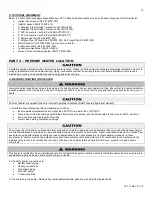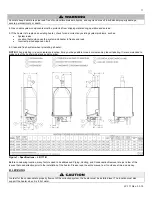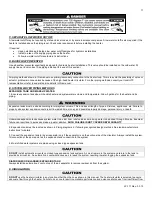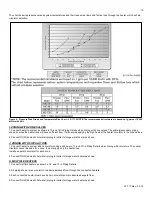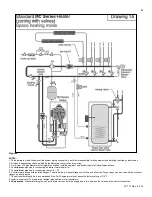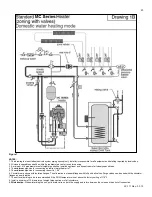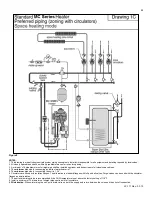
13
LP-171 Rev. 3.3.15
Failure to vent the appliance properly will result in serious personal injury or death.
Vents must be properly supported. Appliance exhaust and intake connections are not designed to carry heavy weight. Vent support
brackets must be within 1’ of the appliance and the balance at 4’ intervals. Appliance must be readily accessible for visual inspection for
the first 3’ from the appliance.
DIRECT VENT INSTALLATION OF EXHAUST VENT AND INTAKE PIPE
When installing a direct vent, combustion air must be drawn from the outdoors directly into the appliance intake, and exhaust must
terminate outside. There are two basic direct vent options detailed in this manual: 1. Side Wall Venting and 2. Roof Venting.
Be sure to locate the appliance such that the exhaust vent and intake piping can be routed through the building and properly
terminated. Different vent terminals can be used to simplify and eliminate multiple penetrations in the building structure (see Optional
Equipment in Venting Section). The exhaust vent and intake piping lengths, routing and termination methods must all comply with the
methods and limits given in the Venting section of this manual.
When installing a combustion air intake from outdoors, care must be taken to utilize uncontaminated combustion air.
NOTE: To
prevent combustion air contamination, see
Table 1
.
Do not attempt to vent this appliance by any means other than those described in this manual. Doing so will void the warranty, and may
result in severe personal injury or death.
F. PREVENT COMBUSTION AIR CONTAMINATION
Install intake air piping for the heater as described in the Venting section. Do not terminate exhaust in locations that can allow
contamination of intake air.
PRODUCTS TO AVOID
AREAS LIKELY TO HAVE CONTAMINANTS
Spray cans containing fluorocarbons
Dry cleaning/laundry areas and establishments
Permanent wave solutions
Swimming pools
Chlorinated waxes/cleaners
Metal fabrication plants
Chlorine-based swimming pool chemicals
Beauty shops
Calcium chloride used for thawing
Refrigeration repair shops
Sodium chloride used for water softening
Photo processing plants
Refrigerant leaks
Auto body shops
Paint or varnish removers
Plastic manufacturing plants
Hydrochloric or Muriatic acid
Furniture refinishing areas and establishments
Cements and glues
New building construction
Antistatic fabric softeners used in clothes dryers
Remodeling areas
Chlorine-type bleaches, laundry detergents, and cleaning solvents
Garages and workshops
Adhesives used to fasten building products
Table 1 - Contaminant Table
You must pipe outside air to the heater air intake. Ensure that the intake air will not contain any of the contaminants listed in Table 1.
For example, do not pipe intake near a swimming pool. Also, avoid areas subject to exhaust fumes from laundry facilities. These areas
always contain contaminants. Contaminated air will damage the heater, resulting in possible substantial property damage, severe
personal injury, or death.
G. REMOVING AN EXISTING HEATER FROM AN EXISTING COMMON VENT SYSTEM
Do not install the heater into a common vent with any other appliance. This will cause flue gas spillage or appliance malfunction,
resulting in possible substantial property damage, severe personal injury, or death.
NOTE: DAMAGE TO THE HEATER CAUSED BY EXPOSURE TO CORROSIVE VAPORS IS NOT COVERED BY WARRANTY.
(Refer to the limited warranty for complete terms and conditions).
Summary of Contents for MC120
Page 21: ...21 LP 171 Rev 3 3 15 M PIPING DETAILS Figure 5 ...
Page 53: ...53 LP 171 Rev 3 3 15 Figure 30 ...
Page 71: ...71 LP 171 Rev 3 3 15 Figure 34 ...
Page 72: ...72 LP 171 Rev 3 3 15 Figure 35 ...
Page 73: ...73 LP 171 Rev 3 3 15 Figure 36 ...
Page 76: ...76 LP 171 Rev 3 3 15 ...
Page 77: ...77 LP 171 Rev 3 3 15 ...










